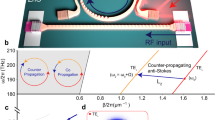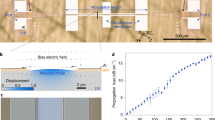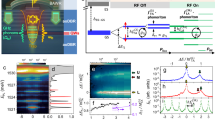Abstract
Achieving non-reciprocal light propagation via stimuli that break time-reversal symmetry, without magneto-optics, remains a major challenge for integrated nanophotonic devices. Recently, optomechanical microsystems in which light and vibrational modes are coupled through ponderomotive forces have demonstrated strong non-reciprocal effects through a variety of techniques, but always using optical pumping. None of these approaches has demonstrated bandwidth exceeding that of the mechanical system, and all of them require optical power; these are both fundamental and practical issues. Here, we resolve both challenges by breaking time-reversal symmetry using a two-dimensional acoustic pump that simultaneously provides a non-zero overlap integral for light–sound interaction and also satisfies the necessary phase-matching. We use this technique to produce a non-reciprocal modulator (a frequency shifting isolator) by means of indirect interband scattering. We demonstrate mode conversion asymmetry up to 15 dB and efficiency as high as 17% over a bandwidth exceeding 1 GHz.
This is a preview of subscription content, access via your institution
Access options
Access Nature and 54 other Nature Portfolio journals
Get Nature+, our best-value online-access subscription
$29.99 / 30 days
cancel any time
Subscribe to this journal
Receive 12 print issues and online access
$209.00 per year
only $17.42 per issue
Buy this article
- Purchase on Springer Link
- Instant access to full article PDF
Prices may be subject to local taxes which are calculated during checkout





Similar content being viewed by others
References
Huang, D. et al. Dynamically reconfigurable integrated optical circulators. Optica 4, 23–30 (2017).
Bi, L. et al. On-chip optical isolation in monolithically integrated non-reciprocal optical resonators. Nat. Photon-. 5, 758–762 (2011).
Peng, B. et al. Parity-time-symmetric whispering-gallery microcavities. Nat. Phys. 10, 394–398 (2014).
Sayrin, C. et al. Nanophotonic optical isolator controlled by the internal state of cold atoms. Phys. Rev. A 5, 041036 (2015).
Scheucher, M., Hilico, A., Will, E., Volz, J. & Rauschenbeutel, A. Quantum optical circulator controlled by a single chirally coupled atom. Science 354, 1577 (2016).
Kang, M. S., Butsch, A. & Russell, P. S. J. Reconfigurable light-driven opto-acoustic isolators in photonic crystal fibre. Nat. Photon-. 5, 549–553 (2011).
Kim, J., Kim, S. & Bahl, G. Complete linear optical isolation at the microscale with ultralow loss. Sci. Rep. 7, 1647 (2017).
Poulton, C. G. et al. Design for broadband on-chip isolator using stimulated Brillouin scattering in dispersion-engineered chalcogenide waveguides. Opt. Express 20, 21235–21246 (2012).
Shen, Z. et al. Experimental realization of optomechanically induced non-reciprocity. Nat. Photon-. 10, 657–661 (2016).
Fang, K. et al. Generalized non-reciprocity in an optomechanical circuit via synthetic magnetism and reservoir engineering. Nat. Phys. 13, 465–471 (2017).
Ruesink, F., Miri, M.-A., Alu, A. & Verhagen, E. Nonreciprocity and magnetic-free isolation based on optomechanical interactions. Nat. Commun. 7, 13662 (2016).
Dong, C.-H. et al. Brillouin-scattering-induced transparency and non-reciprocal light storage. Nat. Commun. 6, 6193 (2015).
Halperin, B. I. Quantized Hall conductance, current-carrying edge states, and the existence of extended states in a two-dimensional disordered potential. Phys. Rev. B 25, 2185–2190 (1982).
Wang, Z., Chong, Y., Joannopoulos, J. D. & Soljačić, M. Observation of unidirectional backscattering-immune topological electromagnetic states. Nature 461, 772–775 (2009).
Hafezi, M., Mittal, S., Fan, J., Migdall, A. & Taylor, M. J. Imaging topological edge states in silicon photonics. Nat. Photon-. 7, 1001–1005 (2013).
Susstrunk, R. & Huber, S. D. Observation of phononic helical edge states in a mechanical topological insulator. Science 349, 47–50 (2015).
Kim, S., Xu, X., Taylor, J. M. & Bahl, G. Dynamically induced robust phonon transport and chiral cooling in an optomechanical system. Nat. Commun. 8, 205 (2017).
Aspelmeyer, M., Kippenberg, T. J. & Marquardt, F. Cavity optomechanics. Rev. Mod. Phys. 86, 1391–1452 (2014).
Kim, J., Kuzyk, M. C., Han, K., Wang, H. & Bahl, G. Non-reciprocal Brillouin scattering induced transparency. Nat. Phys. 11, 275–280 (2015).
Kuhn, L., Heidrich, P. F. & Lean, E. G. Optical guided wave mode conversion by an acoustic surface wave. Appl. Phys. Lett. 19, 428–430 (1971).
Hwang, I. K., Yun, S. H. & Kim, B. Y. All-fiber-optic nonreciprocal modulator. Opt. Lett. 22, 507–509 (1997).
Yu, Z. & Fan, S. Complete optical isolation created by indirect interband photonic transitions. Nat. Photon-. 3, 91–94 (2009).
Lira, H., Yu, Z., Fan, S. & Lipson, M. Electrically driven nonreciprocity induced by interband photonic transition on a silicon chip. Phys. Rev. Lett. 109, 033901 (2012).
Shin, H. et al. Tailorable stimulated Brillouin scattering in nanoscale silicon waveguides. Nat. Commun. 4, 1944 (2013).
Kittlaus, E. A., Otterstrom, N. T. & Rakich, P. T. On-chip inter-modal Brillouin scattering. Nat. Commun. 8, 15819 (2017).
Dostart, N., Kim, S. & Bahl, G. Giant gain enhancement in surface-confined resonant stimulated Brillouin scattering. Laser Photon-. Rev. 9, 689–705 (2015).
Agarwal, G. S. & Jha, S. S. Multimode phonon cooling via three-wave parametric interactions with optical fields. Phys. Rev. A 88, 013815 (2013).
Xiong, C., Pernice, W. H. P. & Tang, H. X. Low-loss, silicon integrated, aluminum nitride photonic circuits and their use for electro-optic signal processing. Nano Lett. 12, 3562–3568 (2012).
Xiong, C. et al. Aluminum nitride as a new material for chip-scale optomechanics and nonlinear optics. New J. Phys. 14, 095014 (2012).
Tadesse, S. A. & Li, M. Sub-optical wavelength acoustic wave modulation of integrated photonic resonators at microwave frequencies. Nat. Commun. 5, 5402 (2014).
Li, H., Tadesse, S. A., Liu, Q. & Li, M. Nanophotonic cavity optomechanics with propagating acoustic waves at frequencies up to 12 GHz. Optica 2, 826–831 (2015).
Piazza, G., Stephanou, P. J. & Pisano, A. P. Piezoelectric aluminum nitride vibrating contour-mode MEMS resonators. J. Micro. Syst. 15, 1406–1418 (2006).
Kang, M. S., Brenn, A. & St.J. Russell, P. All-optical control of gigahertz acoustic resonances by forward stimulated interpolarization scattering in a photonic crystal fiber. Phys. Rev. Lett. 105, 153901 (2010).
Knappe, S. et al. A microfabricated atomic clock. Appl. Phys. Lett. 85, 1460–1462 (2004).
Esnault, F.-X. et al. Cold-atom double-Λ coherent population trapping clock. Phys. Rev. A 88, 042120 (2013).
Gustavson, T. L., Bouyer, P. & Kasevich, M. A. Precision rotation measurements with an atom interferometer gyroscope. Phys. Rev. Lett. 78, 2046–2049 (1997).
Peters, A., Chung, K. Y. & Chu, S. High-precision gravity measurements using atom interferometry. Metrologia 38, 25 (2001).
Blanshan, E., Rochester, S. M., Donley, E. A. & Kitching, J. Light shifts in a pulsed cold-atom coherent-population-trapping clock. Phys. Rev. A 91, 041401 (2015).
Fan, L. et al. Integrated optomechanical single-photon frequency shifter. Nat. Photon-. 10, 766–770 (2016).
Luo, L.-W. et al. WDM-compatible mode-division multiplexing on a silicon chip. Nat. Commun. 5, 3069 (2014).
Acknowledgements
This material is based on research sponsored by the US Air Force Research Laboratory (AFRL) under agreement no. FA9453-16-1-0025 and by the US Air Force Office of Scientific Research (Young Investigator grant FA9550-15-1-0234). The US Government is authorized to reproduce and distribute reprints for Governmental purposes notwithstanding any copyright notation thereon. The views and conclusions contained herein are those of the authors and should not be interpreted as necessarily representing the official policies or endorsements, either expressed or implied, of AFRL and the Defense Advanced Research Projects Agency (DARPA) or the US Government. D.B.S. would also like to acknowledge support from a US National Science Foundation Graduate Research Fellowship.
Author information
Authors and Affiliations
Contributions
D.B.S. and G.B. conceived the idea and, with S.K., developed the theory. D.B.S. fabricated the device, conducted the experiment and analysed the data. All authors contributed to writing the paper. G.B. supervised all aspects of this project.
Corresponding author
Ethics declarations
Competing interests
The authors declare no competing financial interests.
Additional information
Publisher’s note: Springer Nature remains neutral with regard to jurisdictional claims in published maps and institutional affiliations.
Supplementary information
Supplementary Information
Supplementary theory and results; Supplementary Table 1; Supplementary Figures 1–7; Supplementary references.
Rights and permissions
About this article
Cite this article
Sohn, D.B., Kim, S. & Bahl, G. Time-reversal symmetry breaking with acoustic pumping of nanophotonic circuits. Nature Photon 12, 91–97 (2018). https://doi.org/10.1038/s41566-017-0075-2
Received:
Accepted:
Published:
Issue Date:
DOI: https://doi.org/10.1038/s41566-017-0075-2
This article is cited by
-
An optoacoustic field-programmable perceptron for recurrent neural networks
Nature Communications (2024)
-
Passive bias-free non-reciprocal metasurfaces based on thermally nonlinear quasi-bound states in the continuum
Nature Photonics (2024)
-
Optomechanical ring resonator for efficient microwave-optical frequency conversion
Nature Communications (2023)
-
Compact, spatial-mode-interaction-free, ultralow-loss, nonlinear photonic integrated circuits
Communications Physics (2022)
-
Experimental demonstration of quantum transport enhancement using time-reversal symmetry breaking on a silicon photonic chip
Science China Physics, Mechanics & Astronomy (2022)



